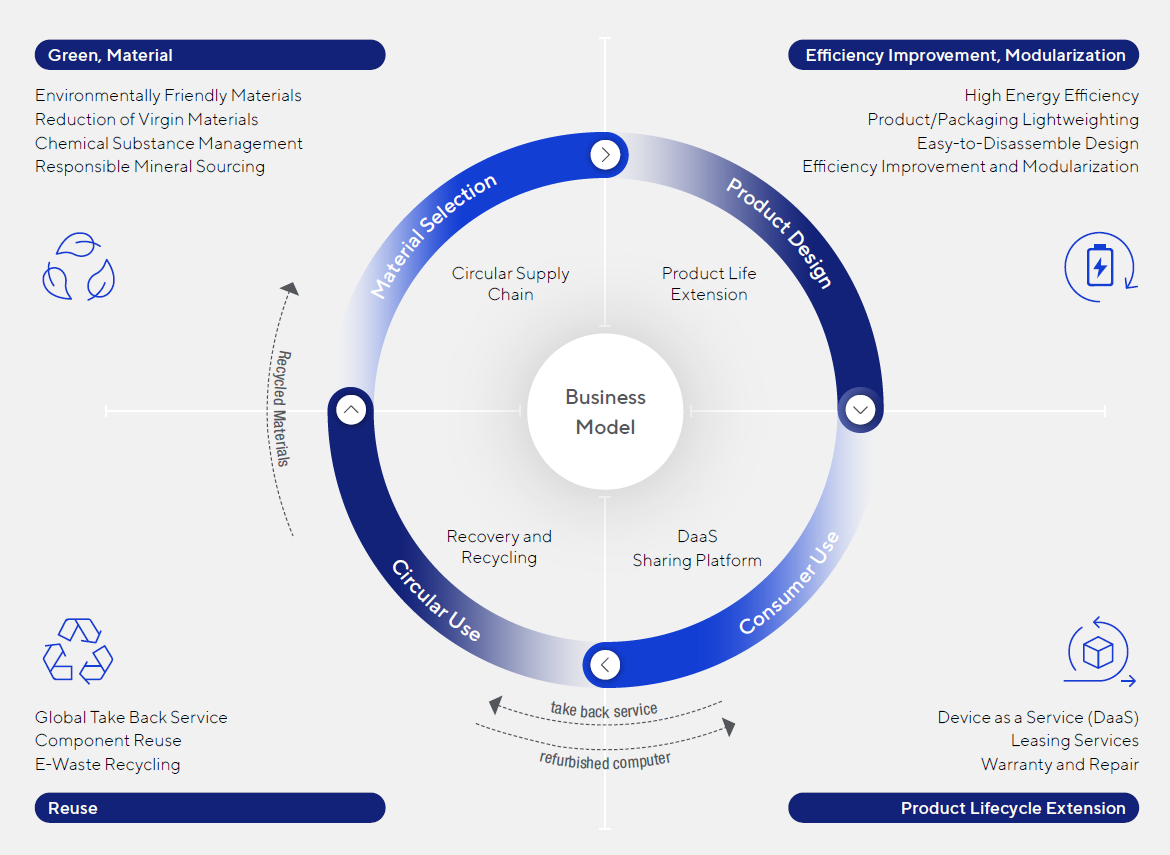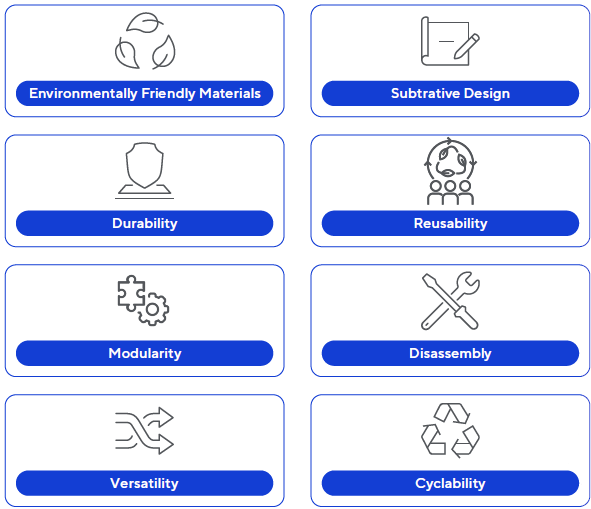Circular Economy Concept
The circular economy model helps reduce the excessive waste of resources and environmental pollution and supports an environmentally friendly business model. To attain this goal, we incorporated the circular economy concept into the design of products and services. We use the four following procedures to support the five business models proposed by the international consulting firm Accenture: Circular Supply Chain, Product Life Extension, Devices as a Service (DaaS), Sharing Platform, and Recovery and Recycling. We incorporated the circular economy strategy into our basic economic framework.

ASUS believes that the circular economy is the true driving force for achieving sustainable product development. Therefore, through a design thinking approach, we create products that closely align with user needs by considering consumer demand, technological feasibility, and business viability. Additionally, we incorporate ASUS' eight sustainable design principles wherever possible, depending on the product characteristics, to enhance product circularity:

Product Life Cycle Assessment
While creating product value, ASUS also pay attention to the impact of product life cycle on the environment. Through the different stages of raw material, such as extraction, manufacturing, transportation, use, disposal, etc., in accordance with the ISO 14040 and 14044 life cycle assessment (LCA) standards, ASUS has quantified the possible environmental impact, and at the same time identified the emission hotspots in the product life cycle, and continued to target and ensure the product carbon footprints have been tracked and decremented.
Raw Material
Raw Material inventory and statistics
- Transport path
- Amount of environmentally friendly materials Used
- Total raw material usage
- Carbon emission data of each material
Utilization of environmentally friendly materials, including post-consumer recycled plastics, recycled paper, and forest sustainable certified paper materials.

Manufacture
Manufacture process Data inventory
- Water consumption
- Energy used
- Waste generation
- Amount of sewage
Supply chain management, involving the promotion of renewable energy usage and the adoption of low-carbon processes.

Transportation
Transportation Data inventory
- Mode of transport
- Transport path/distance
- Distribution load
Packaging material lightweighting design to enhance transportation efficiency.

Use
Electricity Data inventory
- Electricity coefficient of the Country of Sale
- Electricity consumption of products
Product energy-saving design, meeting the stringent international energy consumption standard ENERGY STAR®, further improving energy-saving design of products.

Disposal
Disposal Data inventory
- WEEE product waste recyclable ratio after dismantling, computer conversion ratio, and landfill ratio after incineration
- The distance from the sales recycling service locations to the cooperative recycling processor, as well as the method of transportation and dismantling.
Establishment of takeback services, collaborating with recycling companies meeting internationally recognized electronic recycling standards to avoid wasting resources
Application of Circular Economy
Enhancing Consumers’ the “Right to Know” and the “Right to Choose”, ASUS Launches the Digital Product Passport (DPP)
To enhance consumers' "right to know" and "right to choose," the European Union is promoting the Ecodesign for Sustainable Products Regulation (ESPR). This regulation mandates that products sold within the EU must disclose product information through a Digital Product Passport (DPP). The DPP is akin to an "ID card" for products, detailing the entire lifecycle from raw material selection, manufacturing, transportation, sales, repair, usage, second-hand resale, to final disposal. It provides information on the environmental impact at each stage of the product's lifecycle. By scanning a QR code, users can instantly access this information, helping consumers make informed decisions at the time of purchase.
At the 2025 CES launch event, ASUS officially introduced the first digital product passport (DPP) for its commercial laptop, the ExpertBook B series. This initiative highlights ASUS’s commitment to integrating circular economy principles throughout the product lifecycle, while proactively aligning with global trends and regulations, including the European Green Deal and TCO Certified 10 standards. The DPP for the ASUS ExpertBook B series provides detailed product specifications, repair history, and recycling information, delivering greater product transparency to help extend product lifespan. Going beyond regulatory requirements, ASUS also voluntarily discloses product carbon footprint and lifecycle data, empowering consumers and businesses to make more environmentally responsible purchasing decisions.
The Digital Product Passport (DPP) has become a crucial tool for promoting the circular economy, significantly enhancing product information transparency and creating win-win value for both brands and consumers. By combining the DPP with a "one item, one code" system, consumers can scan a unique identifier on the product to access comprehensive information about its origin, manufacturing process, and material composition, enabling more informed purchasing decisions. For brands, this is not just a one-way communication of information but also a vital channel to understand consumer preferences and sustainability needs. By analyzing product sales, eco-friendly characteristics, and customer feedback, brands can better grasp the importance consumers place on sustainability. This understanding allows brands to leverage their core technological advantages to develop differentiated green products, thereby creating higher commercial value and enhancing brand influence.

Performance Outcomes:
- Officially launched the first commercial laptop with a Digital Product Passport, the ExpertBook B series, in 2025.
- Provided detailed product specifications, repair history, and recycling information, enhancing transparency and helping to extend product lifespan.
- Proactively offered product carbon footprint and lifecycle data beyond regulatory requirements, assisting consumers and businesses in making environmentally friendly purchasing decisions.
Product Carbon Footprint, Carbon Neutrality, and ASUS Carbon Partner Service
ASUS conducts Product Life Cycle Assessment (LCA) for all product designs in accordance with ISO 14040:2016 standards. The product lifecycle encompasses the entire process—from raw material extraction, manufacturing, use, to end-of-life disposal—and the elements that thread the lifecycle, such as materials, manufacturing, and supply chain operations, all influence the product’s environmental impact index. To effectively reduce the impact index, ASUS utilizes ISO 14067:2018 to verify the product carbon footprint and identify lifecycle carbon emission hotspots to further improve product design and formulate supply chain carbon reduction plans and objectives.
In 2022, ASUS achieved a significant milestone by having the world’s first commercial laptop verified with ISO 14067:2018 Product Carbon Footprint by the third party. In 2023, ASUS accomplished product carbon neutrality and obtained third-party verification under PAS 2060:2014.
To achieve the goal of low-carbon products, ASUS integrates environmentally friendly materials, implements low-carbon processes through supply chain management planning, and enhances product energy efficiency during the R&D design phase. In 2024, laptops utilizing over 5% post-consumer recycled (PCR) plastic witnessed approximately a 23%1 reduction in overall carbon emissions compared to laptops without any post-consumer recycled (PCR) plastic. Additionally, products exhibiting energy efficiency exceeding ENERGY STAR® standards by over 40% recorded an average reduction of 24.7% in carbon footprint compared to ENERGY STAR® compliant products. ASUS continuously integrates carbon reduction design into product development across all categories to achieve its low-carbon product targets. In 2024, the next-generation Zenbook UX5304 continues the sustainability advantages of its predecessor. It is 66% more energy-efficient than the ENERGY STAR® standard, incorporates post– industrial recycled aluminum in its chassis, recycled plastics in the keyboard, and ocean-bound plastics in the speaker system. The motherboard is free of halogenated flame retardants, and the product continues to maintain its carbon neutrality verification.
In 2023, ASUS launched ASUS Carbon Partner Services, where providing customers to purchase high-quality carbon credits to offset the remaining emissions of their products. This flexible service helps clients meet ESG performance goals and carbon reduction targets. In 2025, commercial customers purchasing ASUS business laptops can opt for ASUS Carbon Partner Service to support the achievement of their corporate decarbonization objectives.
For detailed information on ASUS Carbon Partner Services, please refer to Products and Solutions.
Innovative Project on Metal Analysis of Recycled Laptop Motherboards
Asus is actively engaged in advancing the principles of the circular economy. In pursuit of resource reutilization and reduced-carbon operations within the recycling sector, Asus has partnered with a third-party entity possessing advanced clean metal recovery technologies. This collaboration led to the initiation of the 'Innovative Project for Metal Analysis of Recycled Laptop Motherboards' in 2021. Findings from this project indicate that each metric ton of laptop motherboards contains recoverable precious metals, specifically gold, silver, and palladium, with an estimated value of approximately NT$90,000. This effectively transforms electronic waste into a valuable resource stream. Furthermore, the project involves a comprehensive analysis of metal usage across various product components. Future efforts will focus on the centralized processing of components containing precious metals. This initiative also serves to validate supply chain management practices in responsible mineral sourcing, with a particular emphasis on auditing key manufacturers utilizing responsible metals.

In addition to evaluating the benefits for recycling metals from motherboards in the metal recycling process, we adopted the low-carbon recycling technology and a green agent for zero-cyanide processing. We use mechanical disassembly, sorting, and the wet tin stripping process to quickly and completely remove metals. The efficiency is 15% higher than that of traditional recycling technologies and the wastewater derived therefrom is easier to process compared to traditional processes that use cyanide or aqua regia. Also, It can reduce the carbon emissions in the treatment process. ASUS has adopted the closed loop concept for recycling and reuse and transitions toward the sustainability goal of cradle to cradle to minimize energy and resource consumption and make zero waste possible. We shall increase green competitive advantages and opportunities to respond to future carbon reduction and circular economy development.
Metal Recycling Process: Utilizing Low-Carbon Recovery Techniques

1. Calculation based on ASUS Laptop Product Carbon Footprint Data from 2022 to 2024.

